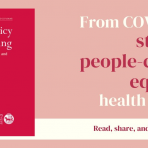By Adam Koon
Successful health finance reforms in several upper and lower middle-income countries have helped drive universal health coverage (UHC) to the top of the global health agenda. Unfortunately, low-income countries have few examples to guide them towards UHC. Instead they will largely be weighing the positive experiences of their wealthier neighbours against their past experiences. They will also look to each other for lessons on navigating the contentious political process that accompanies reform measures.
Kenya is one such country. A transparent and peaceful presidential election earlier this year has left many feeling optimistic. Kenya ratified a new constitution in 2010 and is deeply engaged in the institutional transformation it requires. In the new constitution, Kenyans are guaranteed the right to the “highest attainable standard of health which includes the right to health care services.” In addition, free access to basic health care features prominently in the country’s guiding health policy document. This is important because research has shown that the current mode of health financing in Kenya is unfair with the poor bearing a larger share of the costs.
The recent article by Munge and Briggs contributes to that argument. In this article, the authors use a standard measure of health insurance progressivity called the Kakwani index. Progressivity means that people pay according to their income — in a progressive system the poor pay less, and rich pay more. This approach enabled the authors to look at vertical equity or the ability of those with dissimilar ability to make dissimilar contributions into the finance system. This is in contrast to horizontal equity, which means that those with similar abilities to pay are able to make similar contributions. Recent research on horizontal equity suggests that inequalities exist in the structure of health financing in Kenya. This paper echoes those findings. The collective body of evidence now points to a health financing system that is regressive, with both vertical and horizontal inequalities affecting access to healthcare in Kenya.
The authors rightly point to a number of important policy implications and allude to their salience in current political debates. At the heart of the debate is the need to shift from regressive out-of-pocket payments to a more progressive mode of finance. A general consensus has emerged amongst policy-makers that changing the financial system is a worthwhile endeavor, but the design features of a more equitable system are hotly contested. For example, despite a recent Supreme Court ruling in its favor and repeated attempts by health officials, the contribution rate for employers paying into the National Hospital Insurance Fund (NHIF, established over 40 years ago) has not been adjusted. In an attempt to contain escalating costs, a capitation model of provider payment has been proposed, with vigorous opposition by the health professions. Finally, policies for extending coverage to the informal sector are lacking.
Yet, despite some of these challenges, Kenya remains committed to UHC. It featured in the presidential election, occupies a central part of the new administration’s agenda, and is now firmly rooted in the public discourse around healthcare. Changes are currently underway that should help nudge Kenya further down the path towards UHC. On June 1st, 2013, President Uhuru Kenyatta announced that maternal healthcare (including deliveries) would now be free in all public facilities. Additionally, user fees were waived in public dispensaries and health centers. Importantly, a Health Sector Services Fund has been created to compensate facilities for the loss of revenue following user fee withdrawal. Changes are also being made to the governance of the NHIF, its benefits package, and the type of participants included in the scheme.
There is a sizable degree of activity in the health sector in Kenya and it has yet to be seen how these new developments will equitably re-align access to care. More research, particularly policy analysis, should be conducted that looks at the process by which some reform measures are adopted and others have stalled. In this way, hopefully Kenya can provide some important insight for other low-income countries embarking down their own paths towards UHC. Also, through a process of reflection, policy-makers should be able to gauge whether or not reform measures accurately reflect the values espoused by the wider UHC movement.
Adam Koon is a Research Fellow and PhD student in Health Policy and Systems Research in the Department of Global Health and Development at the London School of Hygiene and Tropical Medicine
















